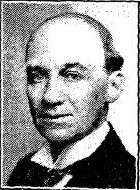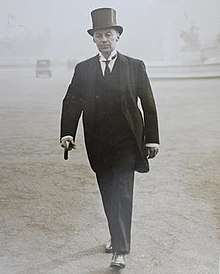Hastings Lees-Smith
Hastings Bertrand Lees-Smith PC (26 January 1878 – 18 December 1941) was a British Liberal turned Labour politician who was briefly in the cabinet as President of the Board of Education in 1931. He was the acting Leader of the Opposition and Leader of the Labour Party (as chairman of the Parliamentary Labour Party) from 1940 during the time Clement Attlee was in government.
Hastings Lees-Smith | |
|---|---|
 | |
| Leader of the Opposition | |
| In office 22 May 1940 – 18 December 1941 | |
| Monarch | George VI |
| Preceded by | Clement Attlee |
| Succeeded by | Frederick Pethick-Lawrence |
| President of the Board of Education | |
| In office 2 March 1931 – 24 August 1931 | |
| Monarch | George V |
| Prime Minister | Ramsay MacDonald |
| Preceded by | Sir Charles Trevelyan, Bt |
| Succeeded by | Sir Donald Maclean |
| Postmaster General | |
| In office 7 June 1929 – 2 March 1931 | |
| Monarch | George V |
| Prime Minister | Ramsay MacDonald |
| Preceded by | Sir William Mitchell-Thomson, Bt |
| Succeeded by | Clement Attlee |
| Personal details | |
| Born | 26 January 1878 British India |
| Died | 18 December 1941 (aged 63) |
| Nationality | British |
| Political party | Labour |
| Alma mater | Queen's College, Oxford |
Family background
Lees-Smith was from an Army family; his father was a Major in the Royal Artillery, and he was born in British India. He was educated at Aldenham School, as a cadet at the Royal Military Academy, Woolwich, and Queen's College, Oxford.[1] Rejecting a military career, he chose academia and was appointed as a lecturer in Public Administration at the London School of Economics in 1906; he remained there throughout his political career. He was also Chairman of the Executive Committee of Ruskin College, Oxford, from 1907 to 1909. He resigned on appointment as Professor of Public Administration at the University of Bristol. In 1909 he went on an extended tour of India to lecture at Bombay on economics and advise on economics teaching; as a result of his experiences he wrote Studies in Indian Economics.[2] He joined a territorial regiment in 1915, and was wounded as a stretcher bearer on the Western Front and invalided out of the armed forces in 1917.[3] In 1938 he distributed 40 British passports to German Jews in Frankfurt thus aiding their escape. The Chest of Surprises describes the Lees-Smith family history.[4]
Liberal MP
At the January 1910 general election Lees-Smith was elected as a Liberal for the two-member Northampton constituency.[5] Unlike his fellow Northampton MP Charles McCurdy, Lees-Smith allied with H. H. Asquith rather than David Lloyd George in the Liberal split during the First World War, and as a consequence was not offered support by the Coalition in the 1918 general election. Rather than defend Northampton (which had been reduced to one member), he moved to the new Don Valley constituency but lost to a Coalition-supported National Democratic and Labour Party candidate. Indicating his estrangement from the Liberal Party, he fought as an 'Independent Radical' although he had been adopted by the local Liberal association. He was the member of Parliament who in July 1917 read Siegfried Sassoon's declaration that the First World War had continued too long and should be ended.[6]
Labour Party

In 1919 Lees-Smith joined the Labour Party. He was picked as Labour candidate for Keighley[2] and won the seat in the 1922 general election,[7] profiting from a divided opposition. He was a noted speaker on banking and on reform of the House of Lords about which he wrote several books including Second Chambers in Theory and Practice (1923). Unfortunately for Lees-Smith, the Conservatives stood down in the 1923 general election and he was defeated by the Liberal candidate.[8] This defeat prevented him from being appointed as a Minister in the first Labour government.
Ministerial office
The collapse of the Liberal Party in the 1924 general election meant that Lees-Smith was able to win his seat back[7] and he was swiftly appointed to a front-bench role. When Labour returned to office in 1929 he was made Postmaster-General[9] where he defended the nationalised Post Office and tried to smarten up the Post Office counters. In a reshuffle in March 1931 he was promoted to President of the Board of Education[10] and sworn of the Privy Council.[10] In this capacity in June he gave the opening address at the Second International Congress of the History of Science.[11] He had only a brief time in office before the government fell, and Lees-Smith refused to follow Ramsay MacDonald into the National Government.[2]
Defeated again in 1931, Lees-Smith again won his seat back in 1935.[2][7] He served on the front bench but was not invited by Winston Churchill to join the Coalition government in 1940; as one of the most senior Labour figures not in office, the responsibilities of running the party were given to him. In his partisan role he strongly supported Churchill's conduct as war leader at a time when the war did not always run in the Allies' favour.[2]
References
- "Hastings Lees-Smith". Ruskin College, Oxford.
- Bellamy, Joyce M.; Martin, David E.; Saville, John (1993). Dictionary of Labour Biography. Springer. p. 180. ISBN 978-1-349-07845-5.
- "Papers of Dr Hastings Bertrand Lees-Smith MP". Archives Hub. Retrieved 26 September 2016.
- Sugarman, Daniel (4 August 2017). "MP Hastings Bertrand Lees-Smith saved dozens of lives, but had no idea". The Jewish Chronicle.
- "leighrayment.com House of Commons: New Romney to Northampton". Archived from the original on 6 October 2018. Retrieved 22 September 2009.
- Max Egremont, Siegfried Sassoon (Picador, 2005)
- "leighrayment.com House of Commons: Keighley to Kilkenny". Archived from the original on 2 October 2018. Retrieved 22 September 2009.
- Hazlehurst, Cameron; Whitehead, Sally; Woodland, Christine (1996). A Guide to the Papers of British Cabinet Ministers 1900–1964. Cambridge University Press. p. 335. ISBN 978-0-521-58743-3.
- "No. 33508". The London Gazette. 21 June 1929. p. 4105.
- "No. 33696". The London Gazette. 6 March 1931. p. 1525.
- "Second International Congress of the History of Science and Technology" (PDF). Nature. 127 (3214): 873–874. June 1931. doi:10.1038/127873b0.
External links
- Hansard 1803–2005: contributions in Parliament by Hastings Lees-Smith
| Parliament of the United Kingdom | ||
|---|---|---|
| Preceded by Herbert Paul John Greenwood Shipman |
Member of Parliament for Northampton 1910–1918 With: Charles McCurdy |
Succeeded by Charles McCurdy |
| Preceded by Sir Robert Clough |
Member of Parliament for Keighley 1922–1923 |
Succeeded by Robert Pilkington |
| Preceded by Robert Pilkington |
Member of Parliament for Keighley 1924–1931 |
Succeeded by George Harvie-Watt |
| Preceded by George Harvie-Watt |
Member of Parliament for Keighley 1935–1941 |
Succeeded by Ivor Thomas |
| Political offices | ||
| Preceded by Sir William Mitchell-Thomson, Bt |
Postmaster-General 1929–1931 |
Succeeded by Clement Attlee |
| Preceded by Sir Charles Trevelyan, Bt |
President of the Board of Education 1931 |
Succeeded by Sir Donald Maclean |
| Preceded by Clement Attlee |
Leader of the Opposition 1940–1941 |
Succeeded by Frederick Pethick-Lawrence |
.svg.png)